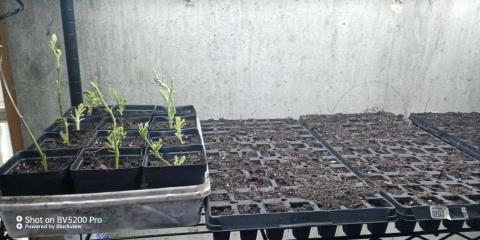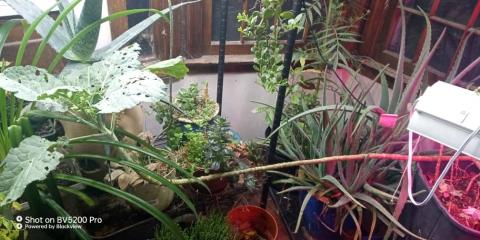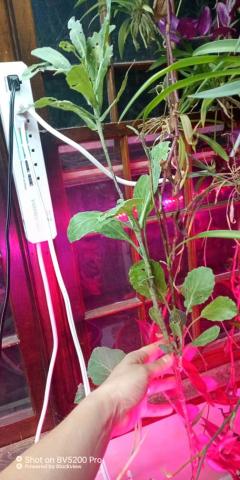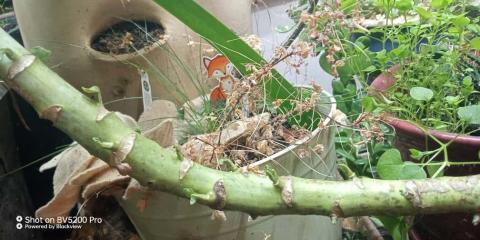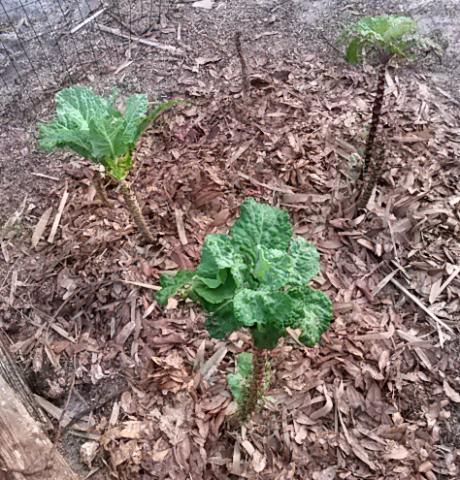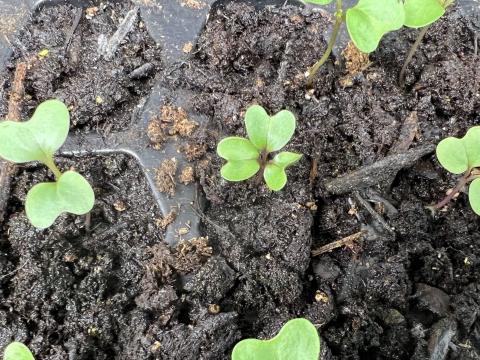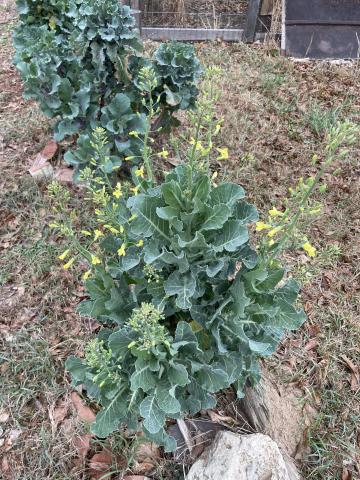In this project we will work collaboratively to improve open-pollinated perennial kale (Brassica oleracea ramosa) for a wide variety of climates and conditions as well as general pest and disease resistance. This population was created by working with a uniquely diverse collection of plants amassed over the last decade. Volunteers are being recruited in order to better identify unique and important plants to include in future crosses.
After freely sharing seeds with a group of EFN volunteer growers two years ago — and unfortunately not receiving reports back from most volunteers — this time I am asking volunteers to literally "buy in" to this project by spending $5.00 (plus shipping) to receive seeds and participate in the project. Seeds can be bought easily through this page on the EFN seed store website. If you don't have a credit card or refuse to buy anything online, please contact me directly.
GENETICS OF PERENNIAL KALE - A little backstory on the genetics of Brassica oleracea ramosa: This subspecies name, ramosa, means “bushing” in Portuguese. Most seldom flower. Only a handful of examples of this subspecies exist anymore. Over the next few years, I hope to import the remaining 20 or so to rescue the best from obscurity. They are often believed to be representatives of early cultivated forms selected from wild Brassica oleracea still found throughout Europe. Genetically they are truly distinct from all other studied Brassica oleracea. Several recessive traits appear to be involved in what makes a plant perennial. Possibly three or more recessive genes are at play. This may explain why our B. oleracea crop types seem to have mostly lost perenniality especially with post-Victorian era varieties. Also, there may be some perennial genetics distinctive to just bush kales. The project seeks to recover fertility back into this perennial phenotype, maintaining this perennial-ness, while focusing on flavor and disease resistance. A collaborative growout of this genepool across diverse environments in the US will advance these goals.
BACKGROUND STORY - The history of this material began with the work of my friend Graham Jenkins-Belohorska in Wales, UK. During the early 2000’s and onward, a small group of us had been communicating about perennial kales, both Brassica napus and Brassica oleracea. Graham had the good fortune of acquiring two related but very different perennial Brassica oleracea ramosa selections, both historic European varieties, ‘Purple Tree Collards’ (PTC) and ‘Daubenton.’ Daubenton was once a forage kale, grown by seed in the Victorian era and earlier. PTC is likely older and its history is obscured in the past. There are a handful of Daubenton plants remaining in Europe and most have not been reported to flower, so it was exciting when he found a form that was known to flower. If you have not seen these two kales, they are unlike any other in several ways. First, they are both very prone to branching and very shy of flowering. Both grow their branches long enough to flop down over time, sometimes advantageously rooting where they touch the ground. PTC is deeply purple and much taller while Daubenton is stout with small yellowish green leaves. To the surprise of our small group, Graham reported in 2011 that his PTC had begun flowering along with his Daubenton. In his plot was a cadre of his favorite Brassicas: ‘Redbor’ kale, Brussels Sprouts, Cabbage, ‘Lacinato’ kale, ‘Walking Stick Tree Kale’, variegated ornamental cabbage, and kohlrabi. He carefully performed hand-pollinations between the two perennial kales and back and forth between the perennials and everything else. In the Spring of 2012, I received a bit of seed from that cross which became the nucleus for this project. From this seed, I grew out approximately 400 plants. Only around 80 survived a particularly cold Pacific NW winter. The majority were heavily bushing and often had the floppy stems of their parent plants. But now they exhibited all sorts of leaf shapes and colors – from ruffled lacinato-like plants, to bushing kales with small leaves akin to Daubenton, to variegated types of various colors, and extremely tall plants reminiscent of Walking Stick Tree Kale, and many more! I then went on to include several more perennial kales I had collected from the West Coast and also the rare and delicately textured Danish Kale called Spis Bladene. Some of the perennials included a naturalized kale patch on the Puget Sound, a collard originally collected from the Umpqua River in Southern Oregon, and a selection of a collard in the Eugene area which is probably related to a green-collard from the Bay Area. Now, after thousands and thousands of plants, several rounds of selection has guided the population toward disease and pest resistance, drought hardiness, cold hardiness, vigor, and of course perenniality.
[Note from EFN organizers: As of now, this is the only EFN project asking volunteers to pay to participate. While the cost is pretty nominal, we didn't come to this decision lightly — since we strongly believe in the free sharing of resources — and, in full transparency, it was our decision (albeit taken in consultation with Chris). We asked Chris to direct volunteers to purchase their seeds through our website for a few reasons: 1) We hope that by having volunteer growers "buy in" to the project, they will be more committed and communicative than last time around; 2) We spent over $125 to get these seeds tested for black leg fungus, a pest responsible for a mandatory quarantine of all Brassica seeds from the Pacific Northwest; and 3) Of course we also want more people to visit our seed store website. We are a non-profit cooperative, and having been doing this work without paying ourselves for over four years now, we think it's only fair to ask volunteers to share in at least a bit of the costs — especially to participate in such a fun, exciting and popular project. Thank you for your understanding.]



